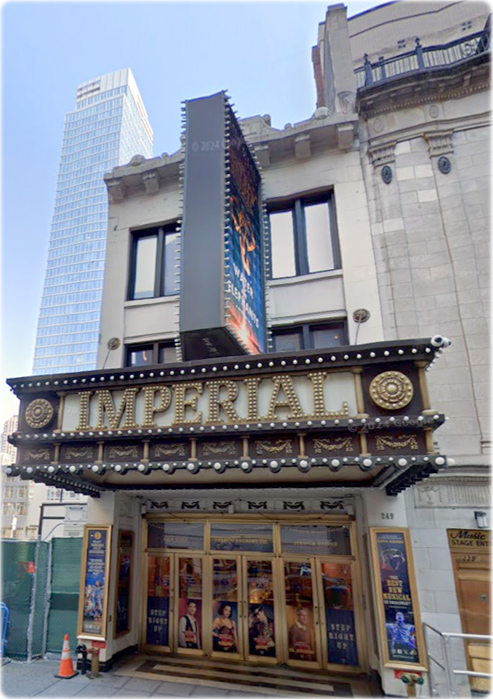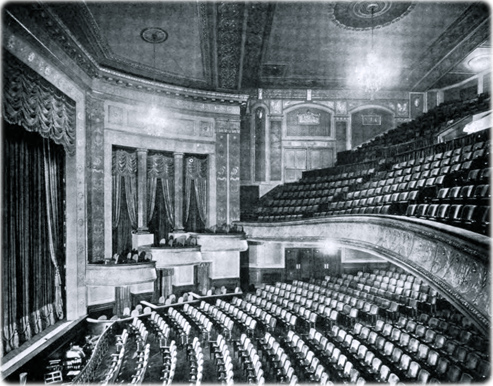|
Copyright © Geographic Guide - Historic Theaters in New York City. |
Imperial Theatre
The historic Imperial Theatre is located at 249 West 45th Street in the Theater District of Midtown Manhattan in NYC. It opened in 1923 and is operated by The Shubert Organization. It has 1,457 seats across two levels. The auditorium interior was designated a New York City designated landmark in 1987.
The Shubert brothers conceived of the Imperial Theatre, their 50th venue in Manhattan, as a home to musical theatre hits. The Imperial Theatre was designed by Herbert J. Krapp with a recessed ceiling and ornamental panels that grace the walls are elaborately decorated with a number of motifs. The rectangular auditorium is wider than it is deep, which allows most audience members to feel close to the stage and performers. The main entrance is through 45th Street, where there is a 3-story white terracotta façade.
The Imperial opened on Christmas Eve, 1923, with the musical Mary Jane McKane (see photo below), which achieved a respectable 151 performance run. In 1972, the Imperial had its greatest success to date with the Stephen Schwartz musical Pippin, notable for Bob Fosse's choreography and Ben Vereen's dancing.
This section of West 45th Street, west of Times Square between Seventh and Eighth avenues is home of others theaters, like Booth Theatre, Gerald Schoenfeld Theatre, Music Box Theatre, Bernard B. Jacobs Theatre and John Golden Theatre.
Here, the description of the original theater structure as published in the Architecture and Building magazine, March, 1924. This article was written by the architect Herbert J. Krapp:
«Shubert's Imperial Theatre, designed primarily for musical productions and reviews, has a large seating capacity and an unusually well equipped stage. The main portion of the building, the theatre proper, is located on a site facing 46th Street, while the entrance to the theatre is from 45th Street, through a three-story building on a narrow site between the Music Box and the Klaw Theatres. The carriage entrance and exit is placed on 46th Street, an arrangement which relieves the traffic congestion on 45th Street. The total seating capacity of the house is 1,650, being divided, 700 on the orchestra floor and 950 in the balcony. There are two tiers of boxes, three on each level either side. At the rear of the orchestra there is an open promenade 20 feet in width into which the entrance corridor opens and at the balcony there is a similar space. In planning the stage equipment particular attention was devoted to the dressing rooms, which are of good size, numerous and excellently appointed. The decorative treatment of the house follows the style of the Empire freely adapted. The entrance foyer is spacious in appearance, with a rubberoid floor laid off in light and dark squares. The walls above the broad marble base are of Travertine with decorative panels in relief forming a frieze. The ceiling is in low relief with pendant lighting fixtures, the decorative treatment following the Empire style. The orchestra promenade and the theatre itself depends for its decoration on low relief and a color scheme of yellow and bronze.
Herbert J. Krapp was the architect of this theatre and the O'Day Construction Co., Inc., were the builders. The electrical engineer was M. J. Levy and the electrical contractors were the Edwards Electrical Construction Co. Mural and decorative painting were done by Vincent Maragliotti. Stage rigging was supplied by Peter Clark, Inc. Strip lights and stage scenic lighting were. installed by the Universal Electric Stage Lighting Co., Inc. The stage act, curtains and valances, box draperies. wall coverings and upholstery were all furnished by Robert Dickie. The ornamental and plain plastering were executed by Donaldson & Hewes, Inc. Woodwork was supplied by the Cornwall Industrial Corporation.»
|
Copyright © Geographic Guide - Historic Theaters in New York City. |



Imperial Theatre at 249 West 45th Street (Google Street View, 2024).
The Imperial's auditorium (Shubert Organization collection). Below, the original auditorium, published in the Architecture and Building magazine, March, 1924.

The Imperial's original main entrance at West 45th St., published in the Architecture and Building magazine, March, 1924.
Imperial Theatre
